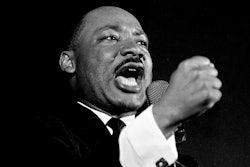Even after nearly 50 years, the names bear repeating: Franklin McCain, David Richmond, Ezell Blair and Joseph McNeil.
They were freshmen at North Carolina A&T State University on Feb. 1, 1960, when they took their seats at the Whites-only lunch counter at Woolworth’s in downtown Greensboro. Four young Blacks tired of segregation laws, they were refused service and asked to leave. But they remained until the counter closed, and when they walked back to their dorm exhilarated, they had set in motion an act of civil disobedience – the sit-in – that took the civil rights movement by storm.
The next day, 25 sit-in protesters showed up. Then 63 filled all but two seats at Woolworth’s. The protest spilled over to the nearby Kress department store, and as word spread across North Carolina and across the South, so did the sit-in: By mid-April, more than 50,000 protesters – ordinary Americans, most of them young – had attacked Jim Crow at the counter.
Dr. Andrew B. Lewis, a historian who has taught at Wesleyan University and the University of Richmond, recounts this pivotal moment in his book, The Shadows of Youth: The Remarkable Journey of the Civil Rights Generation, as he chronicles the roles of a band of young people who gave new direction and courage to the movement at a crucial time.
The book is a shorthand history of the civil rights era -from lynching victim Emmett Till and the Supreme Court’s Brown v. Board of Education decision that outlawed school segregation, to the Montgomery, Alabama, bus boycott, the rise of the Rev. Martin Luther King Jr. and the sit-in phenomenon – as it follows the lives of several key figures who forged the Student Nonviolent Coordinating Committee (SNCC), some becoming far better-known today than those four college students at Greensboro.
From mostly different backgrounds but with a common cause, these activists who were around the age of 20 – John Lewis, Julian Bond, Marion Barry, Stokely Carmichael, Diane Nash, Bob Moses and Bob Zellner among them – saw the sit-in as a tool to spread the movement for social justice to the grassroots South. There would be others: Freedom Rides, Freedom Summer in Mississippi, the Children’s Crusade in Birmingham, Alabama and voting-rights marches.
Lewis is covering territory that has been well-traveled by others, such as Taylor Branch with his three-part history of the King years and David Halberstam with The Children, and it is light on fresh analysis. But he distills the vast trove of material on SNCC and the movement with a sure, skillful hand. The book would be an excellent starting point for anyone, particularly young people, wanting to learn about key points in the modern civil rights era and the rise – and fall – of SNCC.
His portrait of Bob Moses, the philosopher-activist in a white T-shirt and bib overalls whose journey took him from Harvard University to Mississippi to Africa and back, would make anyone unfamiliar with him want to learn more. This is true of others in Lewis’ account, such as Zellner, a White Alabama student who remained committed and courageous even when SNCC turned against him.
The second half of the book chronicles SNCC’s downward spiral, the success and prominence of some, and the disillusionment and personal travails of others in its aging cadre. But historian Lewis makes clear how much their fearlessness in youth mattered.
“How this ragtag band with little money, no obvious power, painfully little help from the federal government and the entire White South out to get them, played a starring role in the demise of legal segregation is one of the great adventure stories of American history.”

















